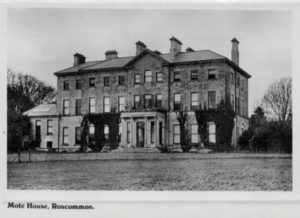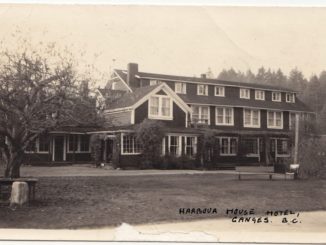The Crofton Baronetcy, of The Mote in County Roscommon, was created in the Baronetage of Ireland on 1 July 1661 for Edward Crofton, as a reward for his record of loyalty to King Charles II during the English Civil War. He sat in the Irish House of Commons as member for Lanesborough, and served as High Sheriff of Roscommon and High Sheriff of Leitrim. He was succeeded in the title by his son Edward, the second Baronet, who sat in the Irish House of Commons as member first for Boyle, and subsequently for Roscommon, and was a member of the Privy Council of Ireland in 1713-14. He was a prominent opponent of King James II of England, and was attainted by the Patriot Parliament of 1689, but recovered his estates the following year. His eldest son, the third baronet, also represented Roscommon in the House of Commons. The title became extinct on the death of the fifth Baronet in 1780.
Baron Crofton is a title in the Peerage of Ireland. It was created in 1797 (as Baroness Crofton) for Dame Anne Crofton. She was the widow of Sir Edward Crofton, 2nd Baronet, of the Mote, who had represented Roscommon in the Irish House of Commons and had been offered a peerage just before his death. The peerage was instead bestowed upon his widow. She was succeeded by her grandson, the second Baron, who had already succeeded as fourth Baronet. He sat in the House of Lords as an Irish Representative Peer from 1840 to 1869 and served as a Lord-in-waiting (government whip in the House of Lords) in the three Conservative administrations of the Earl of Derby and in Benjamin Disraeli’s first government. His son, the third Baron, served as an Irish Representative Peer between 1873 and 1912 and was also State Steward to the Lord Lieutenant of Ireland. His nephew, the fourth Baron, was an Irish Representative Peer from 1916 to 1942. As of 2014 the titles are held by the latter’s great-great-grandson, the eighth Baron, who succeeded his father in 2007.
The Crofton Baronetcy, of the Mote, was created in the Baronetage of Ireland in 1758 for Marcus Crofton, who sat as a Member of the Irish House of Commons for Roscommon. Born Marcus Lowther, he was the husband of Catherine Crofton, daughter of Sir Edward Crofton, 4th Baronet, of the Mote (a title which became extinct in 1780; see Crofton baronets (1661 creation)). Lowther assumed the surname of Crofton. He was succeeded by his son, the aforementioned second Baronet, whose wife was elevated to the peerage in 1797. On his death the baronetcy passed to his son, the third Baronet, and then to the latter’s son, the fourth Baronet, who in 1817 succeeded his grandmother as second Baron Crofton.
The family seat was Mote House, near Ballymurray, County Roscommon.
Crofton Estate – Mote House.

The total holdings of the Croftons in Co Roscommon consisted of 11,053 acres, according to the Bateman Edition of Great Landowners of Great Britain and Ireland in 1883. The size of the Mote Park estate in Ballymurray consisted of c.7000 acres. Although this was a sizeable estate, when compared with others such as the Essex properties consisting of the town of Roscommon itself and extensive lands to the north, totalling some 36,000 acres, it clearly was not the largest.
Mote Park House was built by the Crofton family in the later half of the eighteenth century, preceding the Castle of Mote erected by the family in 1620.[11]
Crofton House, (at Mote Park,shown) was clearly an imposing structure and reflects the influence of neo-classicism prevalent at this time. This style emphasizes for the first time a sense of permanence and security among the landowning class. The house was the most impressive of its type built in Co. Roscommon, the others of this period being located at Runnamoat near Ballymoe, and Sandford House in Castlerea.[12] The house was originally an irregular two-storey-over-basement house, which the architect Richard Morrison more than doubled in size by adding six bays and an extra storey. It had a deep hall with a screen of columns, beyond which a door flanked by niches led into an oval library in the bow on the garden front. These gardens contained many fine architectural features, some of which are still intact. Perhaps the most splendid surviving feature is the original entrance gate consisting of a Doric triumphal arch surmounted by a lion with screen walls linking two identical lodge houses. In 1865 a fire destroyed the entire house at Mote Park, as another had destroyed their castle a century previously. While the house was being re-built in 1866, the family occupied the old barrack room in the farmyard. Following the death of Lord Henry, his nephew, Arthur Edward Crofton became the last of the Croftons to reside at Mote, but moved to England in the 1940s.[13]
- Sir Marcus Crofton, 1st Baronet (died 1774)
- Sir Edward Crofton, 2nd Baronet (1748–1797)
- Sir Edward Crofton, 3rd Baronet (1778–1816)
- Sir Edward Crofton, 4th Baronet (1806–1869) (succeeded as Baron Crofton in 1817)
- Anne Crofton, 1st Baroness Crofton (1751–1817)
- Edward Crofton, 2nd Baron Crofton (1806–1869)
- Edward Henry Churchill Crofton, 3rd Baron Crofton (1834–1912)
- Arthur Edward Lowther Crofton, 4th Baron Crofton (1866–1942)
- Edward Blaise Crofton, 5th Baron Crofton (1926–1974)
- Charles Edward Piers Crofton, 6th Baron Crofton (1949–1989)
- Guy Patrick Gilbert Crofton, 7th Baron Crofton (1951–2007)
- Edward Harry Piers Crofton, 8th Baron Crofton (born 1988)
The heir presumptive is the present holder’s twin brother Charles Marcus George Crofton (born 1988).


Be the first to comment